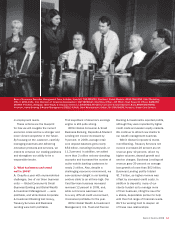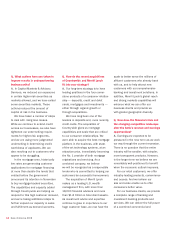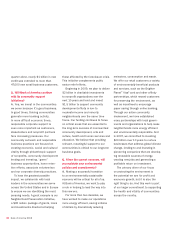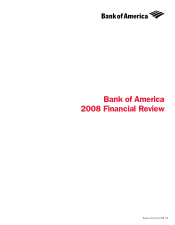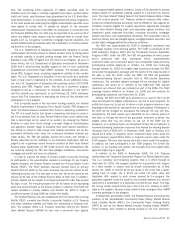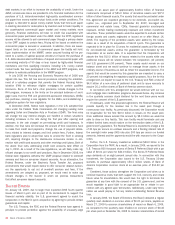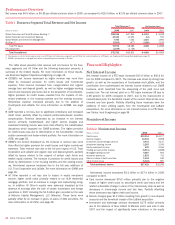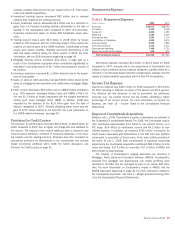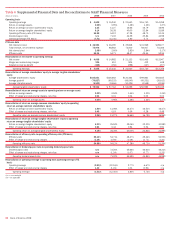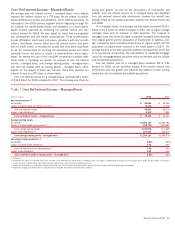Bank of America 2008 Annual Report Download - page 24
Download and view the complete annual report
Please find page 24 of the 2008 Bank of America annual report below. You can navigate through the pages in the report by either clicking on the pages listed below, or by using the keyword search tool below to find specific information within the annual report.debt markets in an effort to increase the availability of credit. Under the
AMLF, nonrecourse loans are provided to U.S. financial institutions for the
purchase of U.S. dollar-denominated high-quality asset-backed commer-
cial paper from money market mutual funds under certain conditions. The
program is intended to assist money market funds that hold such paper
in meeting demands for redemptions by investors and to foster liquidity in
the asset-backed commercial paper market and money markets more
generally. Financial institutions will bear no credit risk associated with
commercial paper purchased under the AMLF. Under the CPFF, registered
issuers will be allowed to sell commercial paper through a primary dealer
to the CPFF subject to certain fees. Pricing will be based on whether the
commercial paper is secured or unsecured. In addition, there are issuer-
based limits on the amount of commercial paper the facility will hold.
Upon implementation of the MMIFF, senior secured funding will be pro-
vided to a series of special purpose vehicles to finance the purchase of
U.S. dollar-denominated certificates of deposit and commercial paper with
a remaining maturity of 90 days or less issued by highly-rated financial
institutions and from qualifying investors including U.S. money market
mutual funds. We have participated in the AMLF and CPFF programs, and
continue to evaluate participation in the MMIFF program.
In July 2008 the Housing and Economic Recovery Act of 2008 was
signed into law. This Act has several provisions including the establish-
ment of a voluntary program that permits the Federal Housing Admin-
istration (FHA) to refinance eligible mortgages for certain qualified
borrowers. Some of this Act’s other provisions include changes to the
FHA program, increases in the limits on the principal balances of mort-
gage loans that the FHA and government-sponsored enterprises (GSEs)
can purchase, creating a new regulator for the GSEs, and establishing a
registration system for loan originators.
In December 2008, federal bank regulators in the U.S. adopted final
rules under the Federal Trade Commission Act changing existing rules
regarding Unfair and Deceptive Acts or Practices (UDAP). The final rules
will change the way interest charges are handled in certain situations
including increases in the rate during the first year after opening and
increases in the rate charged on pre-existing credit card balances. In
addition, the final rules will increase the amount of time customers have
to make their credit card payments, change the use of payment alloca-
tions related to interest charges and limit certain fees. Further, federal
bank regulators plan to adopt final rules to amend the Truth in Lending
Act, requiring changes to the disclosures consumers receive in con-
nection with credit card accounts and other revolving credit plans. Both of
the above final rules addressing credit card accounts take effect on
July 1, 2010. As a result of the new regulations, we will likely make sig-
nificant changes to our credit card practices. Also in December 2008, the
federal bank regulators withdrew the UDAP proposal related to overdraft
services and fees on consumer deposit accounts. As an alternative, the
Federal Reserve, under the Electronic Funds Transfer Act, proposed
amendments that would require banks to offer consumer deposit custom-
ers the opportunity to opt out of overdraft services and fees. If the
amendments are adopted as proposed, we would need to make sig-
nificant changes in the manner in which we process transactions
that affect consumer deposit accounts.
Recent Events
On January 16, 2009, due to larger than expected 2008 fourth quarter
losses of Merrill Lynch and as part of its commitment to support the
financial markets stability, the U.S. government agreed to assist the
Corporation in the Merrill Lynch acquisition by agreeing to provide certain
guarantees and capital.
The U.S. Treasury, the FDIC and the Federal Reserve have agreed in
principle to provide protection against the possibility of unusually large
losses on an asset pool of approximately $118.0 billion of financial
instruments comprised of $81.0 billion of derivative assets and $37.0
billion of other financial assets. The assets that would be protected under
this agreement are expected generally to be domestic, pre-market dis-
ruption (i.e., originated prior to September 30, 2007) leveraged and
commercial real estate loans, CDOs, financial guarantor counterparty
exposure, certain trading counterparty exposure and certain investment
securities. These protected assets would be expected to exclude certain
foreign assets and assets originated or issued on or after March 14,
2008. The majority of the protected assets were added by the Corpo-
ration as a result of its acquisition of Merrill Lynch. This guarantee is
expected to be in place for 10 years for residential assets and five years
for non-residential assets unless the guarantee is terminated by the
Corporation at an earlier date. It is expected that the Corporation will
absorb the first $10.0 billion of losses related to the assets while any
additional losses will be shared between the Corporation (10 percent)
and U.S. government (90 percent). These assets would remain on our
balance sheet and we would continue to manage these assets in the
ordinary course of business as well as retain the associated income. The
assets that would be covered by this guarantee are expected to carry a
20 percent risk weighting for regulatory capital purposes. As a fee for this
arrangement, we expect to issue to the U.S. Treasury and FDIC a total of
$4.0 billion of a new class of preferred stock and to issue warrants to
acquire 30.1 million shares of Bank of America common stock.
In connection with this arrangement we would continue with our cur-
rent mortgage loan modification programs discussed below. Any increase
in the quarterly common stock dividend for the next three years would
require the consent of the U.S. government.
If necessary, under this proposed agreement, the Federal Reserve will
provide liquidity for the residual risk in the asset pool through a
nonrecourse loan facility. As previously discussed, the Corporation would
be responsible for the first $10.0 billion in losses on the asset pool.
Once additional losses exceed this amount by $8.0 billion we would be
able to draw on this facility. This loan facility would terminate and any
related funded loans would mature on the termination dates of the U.S.
government’s guarantee. The Federal Reserve is expected to charge a fee
of 20 bps per annum on undrawn amounts and a floating interest rate of
the overnight index swap (OIS) rate plus 300 bps per annum on funded
amounts. Interest and fee payments would be with recourse to the Corpo-
ration.
Further, the U.S. Treasury invested an additional $20.0 billion in the
Corporation from the TARP. As a result, in January 2009, we issued to the
U.S. Treasury 800 thousand shares of Series R Preferred Stock with a par
value of $0.01 per share for $20.0 billion. The Series R Preferred Stock
pays dividends at an eight percent annual rate. In connection with this
investment, the Corporation also issued to the U.S. Treasury 10-year
warrants to purchase approximately 150.4 million shares of Bank of
America Corporation common stock at an exercise price of $13.30 per
share.
Combined, these actions strengthen the Corporation and allow us to
continue business levels that both support the U.S. economy and create
future value for shareholders. We would have the right to terminate the
guarantee at any time with the consent of the U.S. government, and we
would negotiate in good faith to an appropriate fee or rebate in con-
nection with any agreed upon termination. Additionally, under early termi-
nation we would prepay in full any related outstanding Federal Reserve
loan.
In January 2009, the Board of Directors (the Board) declared a regular
quarterly cash dividend on common stock of $0.01 per share, payable on
March 27, 2009 to common shareholders of record on March 6, 2009,
as compared to the quarterly cash dividend on common stock of $0.32
per share paid on December 26, 2008 to common shareholders of record
22
Bank of America 2008



